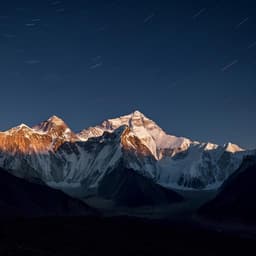
Earth Sciences
Rockfall from an increasingly unstable mountain slope driven by climate warming
M. Stoffel, D. G. Trappmann, et al.
This groundbreaking research by Markus Stoffel, Daniel G. Trappmann, Mattias I. Coullie, Juan A. Ballesteros Cánovas, and Christophe Corona reveals a startling rise in rockfall activity linked to climate change in the Swiss Alps, with unprecedented levels documented since the mid-1980s. Discover how rising summer temperatures are reshaping these vulnerable mountain environments and the urgent call for improved risk reduction measures.
~3 min • Beginner • English
Introduction
Rockfall is a prominent hazard in alpine areas and is presumed to be closely related to permafrost, which is widely degrading in high-mountain environments. Recent Alpine heatwaves (2003, 2015, 2022) produced spikes in rockfall, raising concerns for slope stability and risks to communities and infrastructure. Rockfall can be triggered by multiple drivers, including seismic shaking, snowmelt dynamics, precipitation, permafrost degradation, and freeze–thaw cycles, making it difficult to isolate climate-related controls. The relationship among climate change, permafrost degradation, and rockfall has remained poorly constrained due to limited long-term high-elevation climate data, complex mountain topography, and the scarcity of systematic, multi-decadal rockfall records; existing datasets also suffer from observation biases and non-uniformity. To address these gaps, the study examines the link between climate warming and annual rockfall rates over the past century at a high-elevation, permafrost-affected site (Täschgufer, Swiss Alps) and evaluates changes in the timing and frequency of rockfall activity.
Literature Review
Prior work documents widespread permafrost warming and degradation in high mountains and suggests increased rockfall during heatwaves in the Alps. Studies have highlighted topographic, geological, and cryospheric controls on rockfalls, with evidence that degrading permafrost can reduce slope stability. However, a lack of long-term, high-elevation climate observations and robust, multi-decadal rockfall datasets limits detection of trends and attribution. Existing inventories often bias toward recent, larger events causing damage. Calls exist for bellwether sites and systematic, long-term observations to quantify climate impacts on rockfall and landslides in cryospheric mountain terrain. Additionally, the efficacy of thermal and mechanical processes (e.g., frost weathering, snow cover variability) in rockwall stability has been recognized as potentially important but underdocumented due to data scarcity.
Methodology
The authors reconstructed a 1920–2020 time series of rockfall activity at Täschgufer (Swiss Alps; 46°04′ N, 7°47′ E), where rockfall originates from disintegrated gneissic outcrops between 2,450–2,900 m asl at the seasonal frost–permafrost boundary. A 177-m-wide transect at the upper forest fringe was defined using RockyFor3D-simulated preferential rockfall trajectories. They sampled 375 Larix decidua trees (896 increment cores/cross sections) across two campaigns (2011: 252 trees; 2021: 123 trees). Tree locations were GPS-mapped (<1 m accuracy). Rockfall damage indicators included: (1) visible injuries (overgrown or fresh scars) on stems; and (2) tangential rows of traumatic resin ducts (TRDs) formed within ~7–10 days of wounding, enabling detection of overgrown injuries and sub-seasonal dating when combined with ring anatomy. Standard dendrochronological cross-dating procedures assigned event years. For seasonality, the intra-ring position of GDs (injuries and TRDs) was classified into six sub-annual segments: Dormancy (D: Oct 1–May 15), Early Earlywood (EE: May 16–June 7), Mid Earlywood (ME: June 8–June 30), Late Earlywood (LE: July 1–July 15), Early Latewood (EL: July 16–Aug 15), Late Latewood (LL: Aug 16–Sep 30). A Monte Carlo simulation (1,000 iterations) drew event days within each segment’s date range to estimate day-of-year distributions and temporal trends, fitting local polynomial regressions, quantile regressions, and Theil–Sen slope estimators to quantify shifts in occurrence over time for injuries and for GDs, and across sub-periods (1920–1969, 1970–2020, 2010–2020). To correct for changing sample depth and tree size (DBH) affecting impact likelihood, the Conditional Impact Probability (CIP) approach was applied. Each tree’s impact circle diameter equals DBH plus mean rock diameter (Ø = 0.58 m; mean fragment dimensions estimated from recent deposits). The sum of projected impact circle widths across the transect (L_IC) relative to the plot width (L_plot = 177 m) yields CIP = L_IC / L_plot, used to transform raw rockfall counts to range-corrected counts, accounting for missed events when coverage <100% and for overestimation when coverage >100%. Annual DBH histories were derived by dividing DBH by age to estimate increment rates per tree. Climate-rockfall relationships used gridded daily temperature and precipitation fields for Switzerland (1×1 km; 1763–2020), extracting the grid cell over the site. Analyses employed z-scores over 1920–2020. Correlations were computed at seasonal scales and across moving windows (30–504 days) spanning from May 15 of the previous year to September 30 of the event year (R package dendroTools), for the full period and separately for 1920–1969 and 1970–2020. Decadal trends were examined via nine-year spline smoothing of rockfall and temperature series. Additional comparison used permafrost borehole temperatures at 0.6 m depth from Corvatsch (2001–2020).
Key Findings
- The dataset includes 1,450 growth disturbances (GDs) from 1835–2020; analyses focus on 1920–2020 (≥88 trees; 1,357 GDs; 408 with sub-seasonal precision).
- Seasonality shift: Prior to 1970, rockfall predominantly occurred during dormancy (winter–spring). From 1920–1969, 91% of injuries (n=10) and 55% of GDs (n=29) occurred during dormancy (Oct 1–May 15); only 9% of injuries (n=1) and 45% of GDs (n=24) occurred during the warm season (May 16–Sep 30). After 1970, warm-season rockfall increased markedly: 51% of injuries (n=37) and 37% of GDs (n=130) occurred in the warm season; since 2010, 58% of injuries (n=18) and 70% of GDs (n=42) occurred in the warm season. Monte Carlo-based trend estimates indicate shifts of 63–67 days (injuries) and 42–43 days (GDs) toward later in the year over the past century.
- Frequency increase: Mean annual raw rockfall impacts rose from 4.76 (1920–1940) to 31.23 (1990–2011), influenced by increasing sample depth and DBH. After extending the record with 2021 sampling, mean annual impacts for 2012–2020 were seven (with lower DBH sum). CIP-corrected series reveal substantial increases in rockfall from the late 1940s–early 1950s and especially since the mid-1980s.
- Climate correlations (interannual): For 1920–2020, rockfall correlates with warm summer air temperatures, peaking for 13 July–26 August (45-day window; r=0.48, p<0.01); correlation remains significant after detrending (r=0.37, p<0.01). For 1920–1969, strongest correlations are for 2 July–27 August (57 days; r=0.41 pre-/0.40 post-detrending; p<0.01). For 1970–2020, significant correlations appear for late spring (27 April–28 May; 32 days; r=0.47 both pre-/post-detrending; p<0.01) and a shorter summer window (14 July–16 August; 33 days; r=0.39 pre-/0.37 post-detrending; p<0.01). Precipitation shows no significant correlation.
- Decadal scale: Nine-year spline-smoothed rockfall and temperature series correlate strongly (r=0.69, p<0.01), indicating rockfall increases with persistent warm summers. Decadal patterns align with the end of the Early Twentieth Century Warming (late 1940s–early 1950s; elevated rockfall), subsequent cooler period (mid-1950s to mid-1980s; lower rockfall), and accelerated warming since the mid-1980s (marked rockfall increase). Eyewitness reports and construction of rockfall dams (1988–1998) corroborate heightened activity.
- Lag effects: Enhanced rockfall tends to follow sequences of warm summers (e.g., 1943–1947 preceding 1949–1953 rockfall increase; 1990–1993 warmth preceding 1994–1995 peak), suggesting permafrost degradation at depth and delayed triggering.
- Permafrost indicator: Early summer (27 May–25 June) borehole temperatures at Corvatsch (2001–2020) correlate with rockfall at Täschgufer (r=0.69, p<0.01).
Discussion
The study demonstrates that warming air temperatures, especially sustained warm summers, are strongly associated with increased rockfall activity from permafrost-affected rockwalls. The century-long record shows seasonality shifting from winter–spring (dormancy) toward more frequent warm-season events, consistent with a transition from near-surface freeze–thaw to deeper permafrost instability. Peaks in rockfall following clusters of hot summers indicate lagged responses, likely reflecting the time required for thawing and destabilization of frozen fractures and deeper ground layers. While decadal trends closely track temperature, interannual variability is more weakly coupled due to the roles of snow cover timing, ground heat transport, frost weathering, and hydro-mechanical processes (e.g., meltwater-induced pressure in clefts). The lack of correlation with precipitation suggests thermal forcing dominates at this site. The alignment of enhanced activity with the ETCW and accelerated warming since the mid-1980s supports the hypothesis that degrading permafrost contributes to slope instability. The findings address the research question by providing robust, bias-corrected, long-term evidence linking climate warming and permafrost degradation to elevated rockfall frequency and altered seasonality.
Conclusion
This work provides a rare, century-long, tree-ring-based reconstruction of rockfall from a permafrost-influenced slope, corrected for sampling biases via CIP, and dated with sub-seasonal precision. It establishes that (1) rockfall frequency has increased notably since the mid-1980s and also rose after the ETCW; (2) rockfall seasonality has shifted substantially toward the warm season; and (3) both interannual and decadal rockfall variations correlate with air temperatures, with strong decadal agreement indicating the importance of persistent summer warmth and lagged permafrost responses. The Täschgufer record serves as a benchmark for similar high-mountain environments and underscores that rockfall system responses may be nonlinear with lags and site-specific controls. Anticipated continued warming is likely to further increase rockfall from steep permafrost areas, requiring adaptation of risk mitigation measures in inhabited mountain regions. Future research should expand long-term observations across sites, integrate local ground thermal data (active-layer depth, fracture ice dynamics), and refine process-based models to capture lagged and nonlinear behavior.
Limitations
- Limited high-elevation climate and ground thermal data restrict direct attribution of mechanisms; local measurements of ground heat fluxes, active-layer dynamics, and fracture ice are unavailable for the site.
- Borehole permafrost temperature comparison is from a different site (Corvatsch) and only covers 2001–2020, limiting temporal and spatial representativeness.
- Dendrogeomorphic reconstructions may miss multi-tree impacts or multiple fragments per event; CIP mitigates but cannot eliminate biases, especially at the series ends or when coverage exceeds 100% (potential overestimation) or is low (underestimation).
- Results are site-specific; generalization to other high-mountain regions is uncertain without comparable long-term records.
- Interannual drivers such as snow cover and soil moisture are not directly observed, introducing uncertainty in year-to-year interpretations.
Related Publications
Explore these studies to deepen your understanding of the subject.







